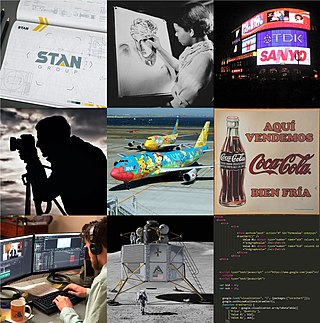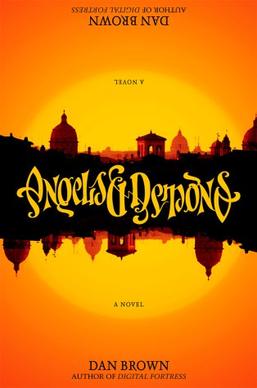Related Research Articles

Drexel University is a private research university with its main campus in Philadelphia, Pennsylvania. Drexel's undergraduate school was founded in 1891 by Anthony J. Drexel, a financier and philanthropist. Founded as Drexel Institute of Art, Science and Industry, it was renamed Drexel Institute of Technology in 1936, before assuming its current name in 1970.

Graphic design is a profession, academic discipline and applied art whose activity consists in projecting visual communications intended to transmit specific messages to social groups, with specific objectives. Graphic design is an interdisciplinary branch of design and of the fine arts. Its practice involves creativity, innovation and lateral thinking using manual or digital tools, where it is usual to use text and graphics to communicate visually.

An ambigram is a calligraphic or typographic design with multiple interpretations as written words. Alternative meanings are often yielded when the design is transformed or the observer moves, but they can also result from a shift in mental perspective.

Daniel Gerhard Brown is an American author best known for his thriller novels, including the Robert Langdon novels Angels & Demons (2000), The Da Vinci Code (2003), The Lost Symbol (2009), Inferno (2013), and Origin (2017). His novels are treasure hunts that usually take place over a period of 24 hours. They feature recurring themes of cryptography, art, and conspiracy theories. His books have been translated into 57 languages and, as of 2012, have sold over 200 million copies. Three of them, Angels & Demons, The Da Vinci Code, and Inferno, have been adapted into films, while one of them, The Lost Symbol, was adapted into a television show.

Professor Robert Langdon is a fictional character created by author Dan Brown for his Robert Langdon book series: Angels & Demons (2000), The Da Vinci Code (2003), The Lost Symbol (2009), Inferno (2013) and Origin (2017). He is a Harvard University professor of history of art and "symbology".

Angels & Demons is a 2000 bestselling mystery-thriller novel written by American author Dan Brown and published by Pocket Books and then by Corgi Books. The novel introduces the character Robert Langdon, who recurs as the protagonist of Brown's subsequent novels. Angels & Demons shares many stylistic literary elements with its sequels, such as conspiracies of secret societies, a single-day time frame, and the Catholic Church. Ancient history, architecture, and symbology are also heavily referenced throughout the book. A film adaptation was released on May 15, 2009.

Milton Glaser was an American graphic designer. His designs include the I Love New York logo, a 1966 poster for Bob Dylan, and the logos for DC Comics, Stony Brook University, and Brooklyn Brewery.
Scott Kim is an American puzzle and video game designer, artist, and author of Korean descent. He started writing an occasional "Boggler" column for Discover magazine in 1990, and became an exclusive columnist in 1999, and created hundreds of other puzzles for magazines such as Scientific American and Games, as well as thousands of puzzles for computer games. He was the holder of the Harold Keables chair at Iolani School in 2008.
Rian Hughes is a British graphic designer, illustrator, type designer, comics artist and novelist.

Angels & Demons is a 2009 American action mystery thriller film directed by Ron Howard and written by Akiva Goldsman and David Koepp, based on Dan Brown's 2000 novel of the same title. It is the sequel to the 2006 film The Da Vinci Code, also directed by Howard, and the second installment in the Robert Langdon film series. However, the novel version was published before The Da Vinci Code novel. Filming took place in Rome, Italy, and the Sony Pictures Studios in Culver City, California. Tom Hanks reprises his role as Professor Robert Langdon, while Ayelet Zurer stars as Dr. Vittoria Vetra, a CERN scientist joining Langdon in the quest to recover a missing vial of antimatter from a mysterious Illuminati terrorist. Producer Brian Grazer, composer Hans Zimmer and screenwriter Akiva Goldsman also return, with David Koepp coming on board to help the latter.

Steven Heller is an American art director, journalist, critic, author, and editor who specializes in topics related to graphic design.

John Workman is an American editor, writer, artist, designer, colorist and letterer in the comic book industry. He is known for his frequent partnerships with writer/artist Walter Simonson and also for lettering the entire run of Grant Morrison/Rachel Pollack's Doom Patrol.
Julian Waters is a calligrapher, type designer and teacher.
William Walsh Hagerty was a teacher, former NASA Adviser, and president of Drexel University.
Robert C. Disque was a professor of electrical engineering and interim president of what is now Drexel University.
Rick Cusick is an American lettering artist, calligrapher, type designer and book designer.
Niels Shoe Meulman is a visual artist, graffiti writer, graphic designer and art director, born, raised and based in Amsterdam, Netherlands. ”Experimenting within the traditional medium of paint-on-canvas, but also unafraid to venture into other domains like conceptual installations and poetry, Niels Shoe Meulman keeps pushing the limits of the global urban contemporary art movement," writes the Museum of Graffiiti, who collected his artwork into their permanent collection, as has the Stedelijk Museum in Amsterdam and The San Francisco Museum of Modern Art, and many private collectors.

Yorgo Tloupas is an awarded French graphic designer and creative director, specialised in logos, typeface design and magazine art direction.

The Robert Langdon franchise consists of American action-adventure mystery-thriller installments, including three theatrical films directed by Ron Howard, and a television series. The films, based on the novel series written by Dan Brown, center on the fictional character of Robert Langdon. Though based on the book series, the films have a different chronological order, consisting of: The Da Vinci Code (2006), Angels & Demons (2009) and Inferno (2016). Despite mixed-to-negative critical reception, the films are considered box office successes, having a combined gross total of $1.5 billion worldwide.

Joe Caroff is an American graphic designer, best known for his design of film posters and corporate logos.
References
- 1 2 3 4 5 6 7 "Cracking the DaVinci Code: Brown's Protagonist Named for Drexel Professor". News Wise. 2006-03-02. Retrieved 2022-07-04.
- 1 2 3 4 "John Langdon". Abstract Art Collective. n.d. Retrieved 2022-07-04.
- 1 2 3 4 "John Langdon". Leyden Diversified. n.d. Retrieved 2022-07-04.
- 1 2 3 4 5 6 7 8 9 10 11 12 13 14 15 16 17 18 Friedensohn, Eric (2016-04-20). "An Interview with Ambigram Master John Langdon". Ef Dot Studio. Retrieved 2022-07-04.
- 1 2 3 4 "A FAREWELL TO A MAN OF LETTERS". Drexel University. 2015-11-02. Retrieved 2022-07-04.
- 1 2 "Personals". The News-Journal. Lancaster, PA. 1921-04-11. Retrieved 2022-07-07.
- ↑ "the social way". The Philadelphia Inquirer. Philadelphia, PA. 1946-04-22. Retrieved 2022-07-07.
- 1 2 3 "G.T. Langdon, former teacher". The Philadelphia Inquirer. Philadelphia, PA. 1968-04-12. Retrieved 2022-07-07.
- 1 2 3 4 Greig, Finlay (2016-10-13). "The man who inspired Robert Langdon: 'I'm neither Harrison Ford nor do I wear Harris Tweed'". iNews. Retrieved 2022-07-04.
- 1 2 3 4 5 6 7 8 9 10 11 Prokhorov, Nikita (2013). Ambigrams Revealed. New Riders. ISBN 9780321855473.
- ↑ Cavicchia, Gaetano (1925). "Professor Courtney Langdon 1861-1924". Bulletin of the American Association of Teachers of Italian. 2 (1): 18. JSTOR 3220817 . Retrieved 2022-07-07.
- 1 2 3 4 5 6 7 "'Wordplay' takes a star turn". OC Register. 2006-05-17. Retrieved 2022-07-04.
- 1 2 3 4 5 "John Langdon Gallery". Optical Spy. n.d. Retrieved 2022-07-04.
- 1 2 3 4 5 6 Kotzin, Mirian N. (2009). "John Langdon, The Per Contra Interview with Miriam N. Kotzin". Per Contra. Retrieved 2022-07-04.
- 1 2 "Class Notes". Connections Magazine. Newtown Square, PA: The Episcopal Academy. 2014. Retrieved 2022-07-07.
- 1 2 3 Bearn, Emily (2005-12-04). "The doodle bug". Telegraph. Archived from the original on 2007-10-14. Retrieved 2022-07-04.
- 1 2 Derakhshani, Tirdad (2009-05-31). "Real-life Langdon teachers in Philly, designed 'Angels & Demons' clues". The Evening Sun. Hanover, PA. Retrieved 2022-07-07.
- ↑ Morse, Diana (2006-05-21). "In his image..." The Morning Call. Allentown, PA. Retrieved 2022-07-07.
- ↑ Chand, Neeraj (2021-09-03). "The Untold Truth Of Robert Langdon". Looper. Retrieved 2022-07-04.
- ↑ Shaw, Paul (2008-07-01). "Flexion". Print Magazine. Retrieved 2022-07-06.
- 1 2 "WORDPLAY: The Language and Illusions of John Langdon". Philadelphia AIGA. 2012. Retrieved 2022-07-04.
- 1 2 3 Peseghin, Lou (2005-11-17). "Letter Man". Philadelphia City Paper. Archived from the original on 2008-07-24. Retrieved 2022-07-06.
- ↑ "TDC2 2007 : Winning Entries". Type Directors Club. 2007. Archived from the original on 2008-06-27. Retrieved 2022-07-07.
- ↑ Heller, Steven (2009-09-16). "Typoliteracy". Print Magazine. Retrieved 2022-07-07.
- ↑ "Class Notes". Connections Magazine. Newtown Square, PA: The Episcopal Academy. 2012. Retrieved 2022-07-07.
- ↑ "DREXEL HOSTS SECOND TEDX TALK". Drexel University. 2013-10-03. Retrieved 2022-07-07.
- ↑ "Painted Words, Tainted Logos: John Langdon". Dexigner. 2010-02-08. Retrieved 2022-07-06.
- ↑ "John Langdon". Drexel University. n.d. Archived from the original on 2007-03-11. Retrieved 2022-07-07.
- ↑ Honeycutt, Brad (2014). THE ART OF DECEPTION: Illusions To Challenge The Eye And The Mind. Watertown, MA: Imagine Publishing. ISBN 9781623540371.
- ↑ Polster, Bukard (2008). Eye Twisters: Ambigrams & Other Visual Puzzles to Amaze and Entertain. New York, NY: Sterling. ISBN 9781402757983.
- ↑ Meulman, Niels "Shoe" (2010). Calligraffiti: The Graphic Art of Niels Shoe Meulman. Berlin, Germany: From Here to Fame. ISBN 9783937946214.
- ↑ "The truth behind new Dan Brown movie Angels & demons". Mirror. 2009-05-15. Retrieved 2022-07-04.